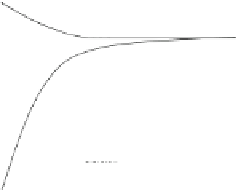Environmental Engineering Reference
In-Depth Information
estimated metal concentration gradients in
rhizosphere based on observed plant to solution
concentration ratio's in different conditions
excluding phytoxic supply
As
depletion
no gradient
accumulation
Cd
Pb
Cd
(highly uncertain, see text)
Ni
As
Zn
Cu
Initial situation
1
2
3
distance from root (mm)
Fig. 8.4
Generalised scheme of dissolved metal or metalloid concentration gradients in the rhi-
zosphere as a result of the ion uptake by roots, mass flow of water and diffusion to the roots.
Depleted conditions occur for metals that are taken up with high absorption power such as cad-
mium. Rhizosphere pore water cannot be sampled equivocally, therefore it becomes more difficult
to interpret metal uptake from bulk soil solution data when concentration gradients are more pro-
nounced. The range of estimated gradients is based on an assumed averaged water use of 200 l/g
dry matter and on solution culture data (e.g. Checkai et al.
1987
; Degryse et al.
2006b
;Wengetal.
2003
) or field based plant-soil solution concentration ratios (Chen et al.
2009
). The estimates for
lead are most uncertain due to the lack of solution culture data at background lead exposure and
since field data are confounded by atmospheric contribution of lead to aerial plant parts
et al.
2006a
). For example, synthetic chelators added to soil increase shoot lead
concentrations (Tandy et al.
2006a
). The suspected mechanism here is
passive (non-
selective) uptake
of metal-complexes through breaks in the endodermis of roots, and
transfer to above ground parts in the xylem (McLaughlin et al.
1997
; Tandy et al.
2006b
). In that scheme, uptake increases linearly with pore water concentration and
has no saturable component.
Recent large-scale surveys of plant metal concentrations and speciation of met-
als in the associated soils demonstrated that pore water concentrations or free ion
activities of the metals did
not
explain the crop concentrations (Chen et al.
2009
;
Hough et al.
2005
). This observation does not invalidate the general concept that
pore water concentrations and free ions are the directly available forms of these ele-
ments. Two processes may be invoked here that complicate the analysis in practice,
i.e.
rhizosphere processes
that alter the pore water composition compared to the
solution that can be sampled, and
ion competition
effects which affect the uptake
rate of the free ion.
8.3.1.2 Rhizosphere Processes
The
rhizosphere
is the soil environment influenced by the roots and the rhizo-
sphere conditions effectively control the supply of contaminants to plant roots.
Unfortunately, the rhizosphere cannot be sampled unequivocally and this is a known
drawback in soil bioavailability research. The physicochemical processes that alter



















Search WWH ::

Custom Search